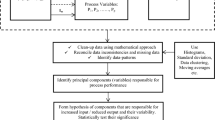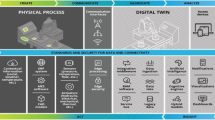Abstract
In manufacturing industries, digitization of design and manufacturing processes adds competitiveness to business in terms of automation, interconnectedness, better user experience, easier process analysis, and machine intelligence. In this paper, we have delineated our experience of estimating efforts required for digitizing design and manufacturing processes of large complex products prevalent in industries where myriad of such processes exist along with their individual complexities. We have analyzed process complexities and reconstructed use case points method of estimation. Prediction error analysis has been performed based on various established methods while validating estimation model. Historical data has been used for model training and validation. A sustained productivity factor of 28.5 consultant-hour/use case point exhibits acceptable average estimation error. We also delve into the replication of digitization effort estimation of homologous components. Analysis of an automotive sheet metal component realization process and its digitization effort estimation has been presented as a proof of concept. The method can be adopted for process digitization in both design and manufacturing realms.
Similar content being viewed by others
References
Aysolmaz B, İren D, Demirörs O (2014) An Effort Prediction Model Based on BPM Measures for Process Automation. 15th Int. Conf. BPMDS 2014, 19th Int. Conf. EMMSAD 2014 147:154–167. https://doi.org/10.1007/978-3-642-38484-4_12
Sharma R, Gao JX (2007) A knowledge-based manufacturing and cost evaluation system for product design/re-design. Int J of Adv Manuf Technol 33(9):856–865. https://doi.org/10.1007/s00170-006-0530-6
Field F, Kirchain R, Roth R (2007) Process cost modeling: strategic engineering and economic evaluation of materials technologies. JOM 59(10):21–32. https://doi.org/10.1007/s11837-007-0126-0
Hameri AP, Nihtila J (1998) Computerized product process: measurement and continuous improvement. Res Eng Des 10(3):166–177. https://doi.org/10.1007/BF01607158
Boehm, B, Abts, C, and Chulani, S (200) Software development cost estimation approaches: a survey. Annals of Software Engineering, Springer, 10(1–4):177–205. https://doi.org/10.1023/A:1018991717352
Moses J (2002) Measuring effort estimation uncertainty to improve client confidence. Softw Qual J 10(2):135–148. https://doi.org/10.1023/A:1020523923715
Ochodek M, Nawrocki J, Kwarciak K (2011) Simplifying effort estimation based on use case points. Infor and Software Technology 53(3):200–213. https://doi.org/10.1016/j.infsof.2010.10.005
Pollmanns J, Hohnen T, Feldhusen J (2013) An information model of the design process for the estimation of product development effort. Smart product engineering: Proc. of the 23rd CIRP Design Conf. 885-894. https://doi.org/10.1007/978-3-642-30817-8_87
Verlaine B, Jureta IJ, Faulkner S (2013) A requirements-based model for effort estimation in service-oriented systems. Service Oriented Computing ICSOC 2013 Workshop 8377:82–94. https://doi.org/10.1007/978-3-319-06859-6_8
Arundacahawat P, Roy R, Al-Ashaab A (2009) An analogy based estimation framework for design rework efforts. Global perspective for competitive enterprise, economy and ecology: Proc. of the 16th ISPE Int. Conf. on Concurr Eng, 203–211. https://doi.org/10.1007/978-1-84882-762-2_19
Anda B, Angelvik E, Ribu K (2002) Improving estimation practices by applying use case models. 4th Int Conf Prod Focused Softw Process Improv, PROFES 2002, 383–397. https://doi.org/10.1007/3-540-36209-6_32
da Silva, CMB, Loubach DS, da Cunha AM (2008) Applying the use case points effort estimation technique to avionics systems. Proc. of Digital Avionics Systems Conference, DASC2008 5.B.4-1 - 5.B.4-10. https://doi.org/10.1109/DASC.2008.4702849
Jacobson I, Christerton M et al (1992) Object oriented software engineering, a use case driven approach. Addison-Wesley
Karner G (1993) Metrics for Objectory. Diploma thesis, University of Linköping, Sweden. No. LiTH-IDA-Ex-9344:21
Port D, Korte M (2008) Comparative studies of the model evaluation criterions MMRE and PRED in software cost estimation research. Proc. of 2nd ACM IEEE Int. symposium on empirical software Engg. and measurement, ESEM 08, 51-60. https://doi.org/10.1145/1414004.1414015
Shepperd M, Schofield C (1997) Estimating software project effort using analogies. IEEE transaction on software engineering 23(12):736–743. https://doi.org/10.1109/32.637387
Mohagheghi P, Anda B, Conradi R (2005) Effort estimation of use cases for incremental large-scale software development. Int. Conf. on Software Engineering ICSE’05, 303-311. https://doi.org/10.1109/ICSE.2005.1553573
Schneider G, Winters JP (1998) Applying use cases: a practical guide. Addison-Wesley, ISBN:0-201-30981-5
Kohavi R (1995) A study of cross-validation and bootstrap for accuracy estimation and model selection. Proc Int Joint Conf on Artificial Intelligence IJCAI-95:1137–1143
Cockburn A (2001) Writing effective use cases. Addison-Wesley, Boston
Cai ZY, Li MZ, Chen XD (2006) Digitized die forming system for sheet metal and springback minimizing technique. Int J Adv Manuf Technol 28(11):1089–1096. https://doi.org/10.1007/s00170-004-2459-y
Pilani R, Narasimhan K, Maiti SK, Singh UP, Date PP (2000) A hybrid intelligent systems approach for die design in sheet metal forming. Int J Adv Manuf Technol 16(5):370–375. https://doi.org/10.1007/s001700050168
Vosniakos GC, Giannakakis T (2013) A knowledge-based manufacturing advisor for pressworked sheet metal parts. J Intell Manuf 24(6):1253–1266. https://doi.org/10.1007/s10845-012-0664-3
Xu HM, Yuan MH, Li DB (2009) A novel process planning schema based on process knowledge customization. Int J Adv Manuf Technol 44(1):161–172. https://doi.org/10.1007/s00170-008-1804-y
Pal P, Tigga AM, Kumar A (2005) Feature extraction from large CAD databases using genetic algorithm. Elsevier CAD 37(5):545–558. https://doi.org/10.1016/j.cad.2004.08.002
Pal P, Tigga AM, Kumar A (2005) A strategy for machining interacting features using spatial reasoning. Int J Mach Tool Manu 45(3):269–278. https://doi.org/10.1016/j.ijmachtools.2004.08.010
Siller HR, Estruch A, Vila C, Abellan JV, Romero F (2008) Modeling workflow activities for collaborative process planning with product lifecycle management tools. J Intell Manuf 19(6):689–700. https://doi.org/10.1007/s10845-008-0120-6
Pal P (2005) Remaining stock computation for 3D-machining in parametric regime. ASME J of Manuf Sc and Eng 127(4):801–809. https://doi.org/10.1115/1.2034510
Pal P (2008) A reconstruction method using geometric subdivision and NURBS interpolation. Int J Adv Manuf Technol 38(3–4):296–308. https://doi.org/10.1007/s00170-007-1102-0
Pal P (2012) Fast freeform hybrid reconstruction with manual mesh segmentation. Int J Adv Manuf Technol 63(9):1205–1215. https://doi.org/10.1007/s00170-012-3986-6
Pal P, Ballav R (2007) Object shape reconstruction through NURBS surface interpolation. Int J Prodn Research 45(2):287–307. https://doi.org/10.1080/00207540600688481
Author information
Authors and Affiliations
Corresponding author
Rights and permissions
About this article
Cite this article
Pal, P., Ghosh, K.K. Estimating digitization efforts of complex product realization processes. Int J Adv Manuf Technol 95, 3717–3730 (2018). https://doi.org/10.1007/s00170-017-1442-3
Received:
Accepted:
Published:
Issue Date:
DOI: https://doi.org/10.1007/s00170-017-1442-3




